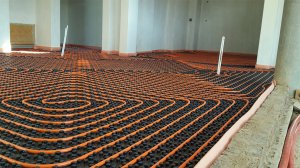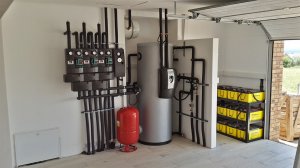Energy-saving unit ideal for SA energy needs



SOPHISTICATION The system is supported by a sophisticated automation system that enables the user to save money without compromising comfort
CONVENIENCE The Kyasol’s heating and cooling system does not require any radiators
South Africa is implementing stricter electricity- and water-saving regulations, which will automatically create opportunity for those operating in the green industry, as companies and individuals will be forced to consider alternative heating and cooling products, says green building solutions provider Kyasol project engineer Istvan Nyul.
He tells Engineering News that the company’s centralised hot water, heating and cooling system switches between different operational modes, depending on a building’s priorities and demand.
“The system is supported by a sophisticated automation system that enables the user to save money without compromising comfort.”
Nyul notes that the system heats the building through low-temperature surface tempering.
Hundreds of metres of multilayer composite pipes (there are about 10 m of piping in 1 m2 of floor) exchange energy between the water circulating through it and the floor screed, he explains, adding that the floor, in turn, functions as a heat exchanger to heat or cool the room.
Advantages Kyasol’s heating and cooling system does not require any radiators, and the low-temperature floor surface enables heating without any hot spots or drafts in the room, says Nyul.
“The same principle is applied to cooling,” he adds.
Another feature of the system is that it provides fresh hot water for houses – a heat pump switches to water-heating mode, by which a water storage tank is heated to a certain temperature.
A freshwater module extracts heat from the tank and warms cold municipal water to a temperature set on the controller.
A warm-water ring in the house can be heated at certain times to ensure the immediate provision of hot water from the tap, notes Nyul.
Further, a heat pump can heat a pool, where applicable. “However, only one task can be done at a time, and providing hot water for the bathrooms and kitchen always takes priority.”
Additional heat sources, such as solar thermal panels as well as gas or water-based fireplaces can be added to further reduce the running time of the heat pump, Nyul points out. Therefore, any electricity requirements from State-owned power utility Eskom are significantly reduced to a minimum, if not to zero, when combined with a photovoltaic system.
Meanwhile, Nyul says that “one unit takes care of all the energy requirements in the building”, adding that the system can also be tied into a home automation system, which enables temperatures and operational modes to be controlled from any smartphone or tablet.
This system also replaces the geysers or solar geysers in a house, all the radiators used for heating a house in winter and traditional air- conditioning units, which are usually distributed throughout a building.
Challenges
Only a handful of companies in the South African market currently design and install these kinds of systems in a way that ensures the safe and efficient operation of the system, avers Nyul.
He adds that the mindset of South Africans in terms of green energy has changed in recent years, as an increasing amount of Kyasol’s clients are willing to invest in green technology for their homes and, in turn, are satisfied with a system that provides peace of mind and possible independence from an external energy supplier.
However, Nyul highlights that several smaller companies that are trying to tap into the green market are creating confusion about the abilities of green heating and cooling systems.
“Several companies have not installed their units properly and, as a result, the systems are not functioning efficiently and safely, if at all.”
He notes that anything built into the walls or the floor, such as heating pipes or supply pipes, cannot be repaired without the user incurring significant expenses, adding that it is, therefore, important to select the right provider for the installation. Most problems occur as a result of design errors that could have been avoided.
Nyul does, however, point out the significant skills shortage in South Africa and explains that a well-trained technician needs to combine electrical, plumbing, refrigeration, air-conditioning, automation and basic building skills to successfully install these types of heating and cooling systems
Article Enquiry
Email Article
Save Article
Feedback
To advertise email advertising@creamermedia.co.za or click here
Comments
Press Office
Announcements
What's On
Subscribe to improve your user experience...
Option 1 (equivalent of R125 a month):
Receive a weekly copy of Creamer Media's Engineering News & Mining Weekly magazine
(print copy for those in South Africa and e-magazine for those outside of South Africa)
Receive daily email newsletters
Access to full search results
Access archive of magazine back copies
Access to Projects in Progress
Access to ONE Research Report of your choice in PDF format
Option 2 (equivalent of R375 a month):
All benefits from Option 1
PLUS
Access to Creamer Media's Research Channel Africa for ALL Research Reports, in PDF format, on various industrial and mining sectors
including Electricity; Water; Energy Transition; Hydrogen; Roads, Rail and Ports; Coal; Gold; Platinum; Battery Metals; etc.
Already a subscriber?
Forgotten your password?
Receive weekly copy of Creamer Media's Engineering News & Mining Weekly magazine (print copy for those in South Africa and e-magazine for those outside of South Africa)
➕
Recieve daily email newsletters
➕
Access to full search results
➕
Access archive of magazine back copies
➕
Access to Projects in Progress
➕
Access to ONE Research Report of your choice in PDF format
RESEARCH CHANNEL AFRICA
R4500 (equivalent of R375 a month)
SUBSCRIBEAll benefits from Option 1
➕
Access to Creamer Media's Research Channel Africa for ALL Research Reports on various industrial and mining sectors, in PDF format, including on:
Electricity
➕
Water
➕
Energy Transition
➕
Hydrogen
➕
Roads, Rail and Ports
➕
Coal
➕
Gold
➕
Platinum
➕
Battery Metals
➕
etc.
Receive all benefits from Option 1 or Option 2 delivered to numerous people at your company
➕
Multiple User names and Passwords for simultaneous log-ins
➕
Intranet integration access to all in your organisation




















